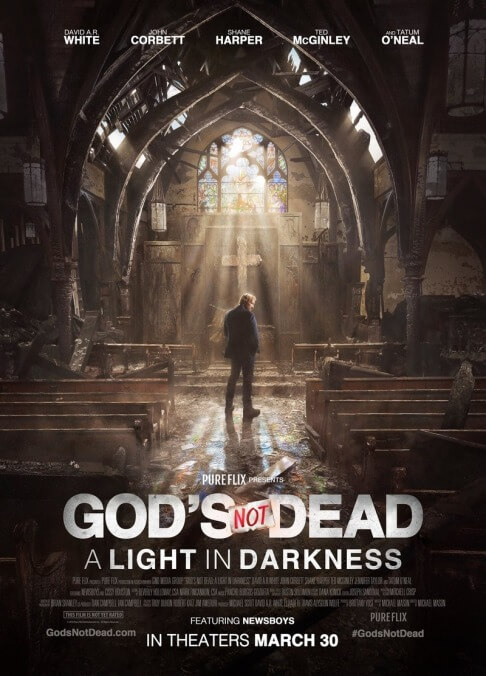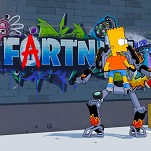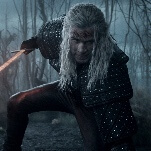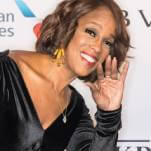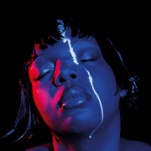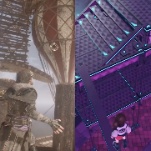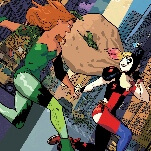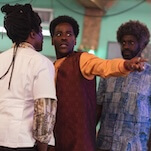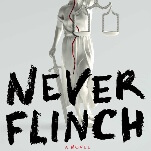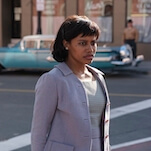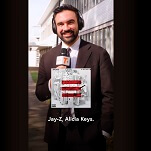Since the 2016 election, President Donald J. Trump has been a point of contention in evangelical circles. On one side, the case is made that it’s wrong to support a man whose every word and deed is plainly antithetical to a rudimentary understanding of Christianity. Others argue that it’s acceptable to support him if, sinful though he undoubtedly is, Trump can act as a vessel of God by banning abortion and lowering taxes for the rich. This position can lead to absurdities, as in the recent example of pastor Robert Jeffress, who was forced to address the Stormy Daniels controversy with the nonsensical statement, “Evangelicals still believe in the commandment: Thou shalt not have sex with a porn star. However, whether this president violated that commandment or not is totally irrelevant to our support of him.” God’s Not Dead: A Light In Darkness is a movie explicitly targeted at evangelicals for Trump. It doesn’t just tap into the bottomless, inexplicable well of paranoia about persecution of white Christians in the United States that the first two installments of this Pure Flix franchise stoked. It also throws in cameos from NRA spokesperson Dana Loesch and Fox News personality Judge Jeanine Pirro, just to make it absolutely clear where the film and its presumptive audience stands.
In the first God’s Not Dead, college student Josh Wheaton (Shane Harper) challenged the professed atheism of philosophy professor Jeffrey Radisson (Kevin Sorbo) via a series of lectures to prove the existence of God. At the climax, Wheaton yelled, “Why do you hate God?” and got an answer: The prof’s wife had died of cancer and that upset him. “Yes, I hate God,” he confessed. Toward film’s end, Radisson gets hit by a car; fortunately, pastor Dave Hill (David A.R. White) and his good buddy, Ghanaian reverend Jude (Benjamin A. Onyango), were on hand for Radisson’s dying moments, just in time to get him to accept Jesus Christ as his personal lord and savior. Whereas the first film took a Crash approach to criss-crossing narratives and the second installment largely shunted Dave for another plotline, he’s front and center in A Light In Darkness, in which people still have to die so that Jesus may be accepted. Jude himself is offed in the first 10 minutes, the casualty of a fire at Dave’s church, but it’s all part of God’s plan to bring another lost soul back to Him.
A Light In Darkness picks up exactly where the last installment left off, with Dave being arrested for failing to produce his sermons in response to a subpoena. The meek pastor never looks for a fight, but the case—quickly dismissed by the courts, as was true of its anomalous real-life inspiration—places his parish in controversy. It’s on university land, and the board decides the church must close (too much of a lightning rod), using eminent domain to seize the property for a new student center. Again, this installment takes a real-life occurrence (the case of Faith Temple Church Vs. Brighton is cited) and amplifies it beyond hysteria. Dave decides to fight the university in court, so he drives up to Chicago to visit his previously unmentioned atheist lawyer brother, Pearce (John Corbett, giving the first-ever credible and appealing performance in this franchise).
What ensues is a kind of Book Of Job experience. By offing Dave’s best friend immediately, A Light In Darkness ups the stakes to imply contemporary American Christians are always at risk of turning into martyrs. Though accidental, the fire was started by ex-Christian college student Adam (Mike C. Manning). His girlfriend, Keaton (Samantha Boscarino), breaks up with him in dialogue that echoes the first film’s climactic exchange. (“I don’t have a problem with God,” “But you do, Adam.”) Drunk and upset, Adam indicates how a secular campus education has corroded his moral foundation by petulantly swiping at a protest sign reading “Evolution is a myth,” then throwing a brick through the church window. Jude must die so that Adam can find his faith again.
The university, the liberal media harping about Dave on televisions the film relentlessly cuts away to: Can’t a decent Christian get a break? And isn’t it appalling how the university would literally tear down a church to, in Dave’s disbelieving words, “advance a political agenda”? His smart-aleck brother claims Christians “love to play the victim,” a way of preemptively justifying and defusing what the film is actually about. Dave loses his temper and attacks Adam when he finds out he’s responsible for the fire, but isn’t that implicitly understandable? “I think it’s time that Christians stand up for themselves,” Dave fumes. “I’m tired of being pushed around.”
If the film eventually comes around to him turning the other cheek, it doesn’t mean it, and the proof is in the cameos. Frustrated Dave might well be paraphrasing Loesch’s video from last April, where she ranted against Trump protesters who “smash windows, burn cars, shut down interstates and airports, bully and terrorize the law-abiding […] The only way we stop this, the only way we save our country and our freedom, is to fight this violence of lies with the clenched fist of truth.” When Loesch appears in the film, it’s to pull a “so much for the tolerant left” line in flagging the university’s decision. Later, Judge Jeanine gets to voice the film’s moral: “It’s a sign of the time: everybody’s yelling, nobody’s listening.” What she means is that the left is yelling and not listening to the right, an assumption the film completely endorses: Trump is a vessel of God and Christians are completely right to be angry about the Deep State trying to sabotage him. A Light In Darkness isn’t as offensive as the first film—it lacks the requisite misogyny and Islamophobia, and does a better job of looking like it’s almost a real movie—but it’s not far behind, an emblematic film for the foul moment.
